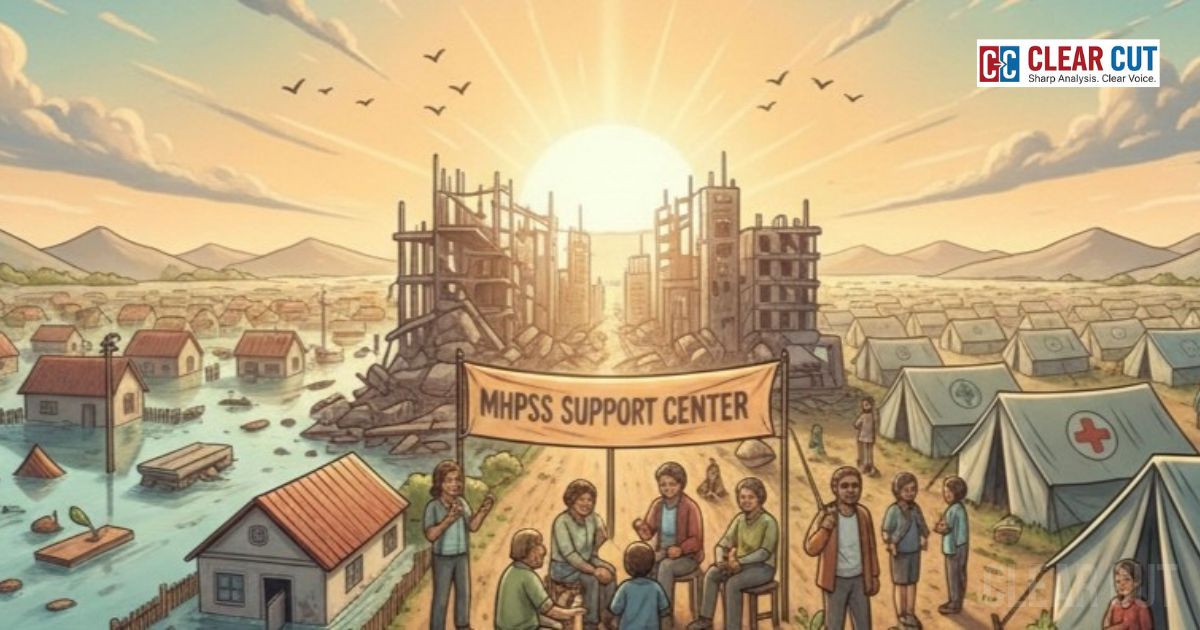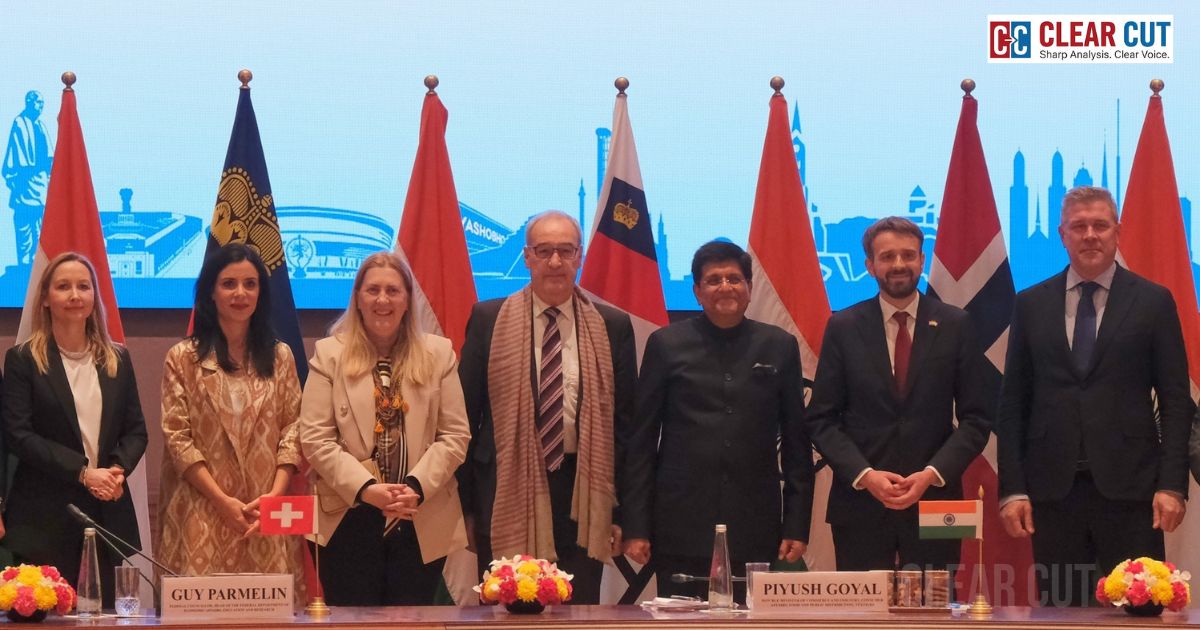Photo Credit: Antara Mrinal
Clear Cut Health Desk
New Delhi, UPDATED: Oct 10, 2025 11:06 IST
Written By: Antara Mrinal
October 10, 2025 marks the World Mental Health Day and the theme this year – “Access to Services: Mental Health in Catastrophes and Emergencies (Disasters)” highlights an issue that is often pushed to the side. When disasters strike – earthquakes, storms, pandemics, conflicts – the need for mental health services rises. The loss, grief, dislocation, insecurity, and changes to communities exacerbate the challenges. But as the mental health needs rise, the access to Mental Health and Psychosocial Support (MHPSS) often crumbles. Closing this gap is not just a matter of humanitarian relief but a matter of public health, social stability, and sustained resilience.
The hidden crisis
The visible scars left by disasters are noted – homes or roofs have collapsed, roads are broken or impassable and supplies are disrupted – but the unseen mental health toll can be profound. The World Health Organization notes that in crisis-affected populations estimates are that 13% will reach a threshold of mild forms of depression, anxiety or PTSD and another 9% may develop moderate or severe mental disorder. In other words, one in five to six people living in disaster zones will need mental health care or psychosocial support.
Emotional suffering is nearly universal: people often experience feelings of anxiety, insomnia, grief, hopelessness, irritability, emotional numbness or somatic symptoms after disasters. While many of these may resolve on their own, symptoms develop into more serious and longer-lasting mental health disorders in a significant minority of individuals (World Health Organization).
Disasters do not create mental health needs out of nowhere, however, they magnify already-present risks and vulnerabilities. In many low- and middle-income families, the mental health systems are already weak or underfunded. Emergencies may make those already weak systems tenuous, as facilities may be destroyed, staff may be displaced or overwhelmed with workload, supply chains for necessary medications may be disrupted, and patient demand may exceed levels. Coordination among various agencies may also fall flat, and mental health care becomes a “forgotten” sector after basic water, food, shelter and infectious disease prevention and control (World Health Organization).
A Guiding Framework for Work in Emergency Situations: Layered Support and Coordination
One of the foundational documents in addressing mental health in disaster situations is the Inter-Agency Standing Committee (IASC) Guidelines on Mental Health and Psychosocial Support in Emergency Settings – which was first published in 2007 and has been revised since then. These guidelines present a layered model of care, from basic service and security to community and individual support, from focal non-specialized psychological first aid to a full clinical mental health system of care (World Health Organization). The idea is to offer support at different levels simultaneously, so that community-level psychosocial activities buffer the majority of psychological distress even while specialized care is reserved for those with severe or persistent disorders (MHPSS Hub).
Along with organizing service delivery, the Guidelines focus on coordination across sectors (health, protection, and education), monitoring and evaluation, human resource capacity, and the need for early preparedness (The MHPSS Network). Recently IASC has also produced the Common Monitoring & Evaluation Framework (Version 2.0), which includes indicators and means to verify coverage and quality of MHPSS responses (The MHPSS Collaborative).
A related and relevant trend is the integration of Disaster Risk Reduction (DRR) and MHPSS planning. Reviews of this trend indicate that practitioners are beginning to comprehend that mental health needs to be addressed pre-disaster (e.g., preparedness, building resilience, policy, and community awareness), but there remains a lack of consensus and formalized frameworks for this integration (MDPI)
Barriers to Access
Access to mental health services in disaster settings is complex due to various structural, social, cultural and system-level barriers. One significant barrier often described is some form of service disruption (while some disrupted services may not ever return to normalcy), such as health facilities that have been destroyed, transportation infrastructure that has been compromised, communication systems that are malfunctioning, and/or health care workers that are displaced. In that chaos of system disruption, even gaining access to a clinic that survived the disaster could be impossible.
Workforce shortages are also a close issue. Even during stable periods, many contexts do not have sufficient professionals in mental health. In emergency settings, the problem is even more pronounced: often there is no specialized staff available, and the demands on services exceed their capacity. In catastrophic emergencies, the training of non-specialized workers or community paraprofessionals may be warranted.
Cultural barriers and stigma are also major factors. Most global guidance acknowledges a continuing reliance on the biomedical model of mental illness, which may conflict in certain circumstances with locally held explanatory models of distress. The problem may be more profound when considering how the term “pathology” may not even be relevant for some cultures, especially when conceptions of suffering, coping, resilience, and community limitations are taken into consideration (PubMed).
Coordination and serendipitously funded interventions are ongoing issues, and in most humanitarian contexts, mental health is underprioritized. Many interventions are often duplicative, poorly planned across clusters, or take place over a limited timeframe. Many organizations struggle to provide continuity of care for people, especially as the emergency progresses through time (Lippincott Journals).
Barriers to access around vulnerability and exclusion are an added layer of complexity. Marginalized groups such as children, older adults, persons with disabilities, and, especially survivors of gender-based violence find additional barriers to accessing services and social supports until explicit positive inclusion is part of the planning overall (BioMed Central).
What Evidence Tells Us: Models That Expand Access
In spite of the challenges, there is a growing evidence base showing evidence-based methods for increasing access to MHPSS in emergencies. One main method is task-sharing or non-specialist delivery: training and supervision of community workers, general health staff or lay counsellors to delivery focused psychosocial interventions or brief therapies. This allows for coverage to expand in low-resource or high demand settings. The IASC Guidelines explicitly support a layered care model.
Psychological First Aid: PFA has been more widely adopted as an early psychological intervention to provide emotional and practical support. While PFA is not intended to be a substitute for therapy, it can help to alleviate acute distress and provide a gateway into further support.
Integration of MHPSS services: MHPSS services can be integrated into existing health services, protection, education, and humanitarian service platforms. This integration embeds mental health into general health care and cross-sectoral efforts, while increasing access to services by making the service less stigmatized and more seamless. Research specifically on disease outbreak response, for example, has shown that mental health can be integrated into response pillars, such as case management, infection control, and coordination (ScienceDirect).
Community-based and peer support approaches: Self-help groups, community mobilization and psychosocial support initiatives led by survivors themselves expand reach, improve cultural fit of the interventions, and promote social connectedness. Systematic reviews investigating MHPSS programmes for children and youth indicate that community-level interventions frequently demonstrate meaningful improvement in psychosocial outcomes.
Operational and comparative studies: these help shed light on models for scaling mental health services in a recovery phase following a disaster. One study compared three models to provide mental health and psychosocial support following different disasters in Sri Lanka, Haiti and the Philippines, highlighting shared issues associated with preserving trained non-specialist staff, supervision, behavior change and evidence of impact (Lippincott Journals).
How the World is Moving Forward
In Japan, a qualitative study conducted in the region really suffering the effects of the Great East Japan Earthquake, looked at long-term MHPSS practice. They found that, years post-disaster, organizations continued to engage in one-on-one counseling, group activities, support for livelihood, awareness campaigns, human resource development, and coordination between organizations, while sign posting unique challenges related to funding, collaboration, and sustainability (BioMed Central).
More recently in China, a scoping review mapped MHPSS programmes in disaster emergency contexts, where, although the diversity of interventions was observable, there was certainly a lack of robust evidence of impact, gap in measuring reach and equity extent(Science Direct).
Putting Access Into Practice: Toward Resilient, Inclusive Systems
How can we improve? The theme of 2025 is not only about responding to emergencies but allowing access to be considered part of disaster preparedness, response, and recovery. Access cannot be an afterthought.
1) Embed MHPSS in national disaster laws, preparedness plans, and emergency responses. This will help ensure that mental health is not expedited but is included from the start. WHO and global policy bodies recommend that MHPSS be involved in health cluster planning and coordination, resource allocation and early deployment (World Health Organization).
2) Invest in workforce development – especially to train and supervise non-specialist providers, so that when disaster strikes you have a trained cadre in place to deliver the “middle layers” of support across communities. Supervisory structures, refresher training, and mental health capacity building must be in place beyond the acute phase of the emergency.
3) Enhance monitoring, evaluation and feedback systems. Using the IASC Common Monitoring & Evaluation Framework to monitor whether services reach the populations, maintain quality, fill gaps and adapt is crucial (The MHPSS Collaborative).
4) Equity and inclusion must be prioritized. Services must include hard to reach populations proactively, such as persons with disabilities, older adults, displaced persons, and survivors of gender-based violence. Inclusion must be considered in programme design – e.g., accessible locations, translation, cultural adaptation, outreach modalities.
5) Harness community, peer and local leadership. Community engagement makes services more acceptable, demand-driven and sustainable. Peer support groups, survivor networks, community psychosocial outreach, and participatory methods can bolster resilience and widen the reach of formal providers.
6) Pursue sustainable financing and integration into health systems. Disaster times offer opportunities: the influx of attention and funds can be leveraged to build longer-term capacity. As WHO notes, emergencies may paradoxically become catalysts for mental health system strengthening (World Health Organization).
Looking Forward: Research Paths & Opportunity
However, notwithstanding that progress, there are still essential gaps in our knowledge that require further exploration. For example, we have only a limited amount of high-quality, comparable data on service coverage and equity in emergencies – who is treated and which populations are neglected. The evidence base around scaling interventions delivered in culturally diverse populations continues to be underdeveloped, particularly for effectiveness, cost and longer-term sustainability. Needs assessment for moving from the emergency state into “routine” service mode also requires development: how do you develop stable community mental health systems from emergency programmes, and how do you assess population-level inclusion – including access to the hardest-to-reach populations?
Finally, we are also lacking in economic research. Governments and donors will frequently ask, “What is the return on investment if we scale MHPSS services in a disaster context?” Without costing and economic analyses, we’re at risk of seeing mental health, once again, fall off the agenda.
Catastrophes and emergencies destroy more than just buildings – they devastate minds, devastate the social order, and devastate communities. In that devastation, access to mental health / psychological support becomes a moral and strategic obligation. World Mental Health Day 2025 will challenge us to not only advocate for access in acute response, but also embedded into the very foundation of disaster preparedness, health systems, and recovery. Achieving that demands coordination, innovation, sustained investment, community leadership, and rigorous evaluation. If we succeed, we strengthen not just individual resilience – but collective recovery, dignity, and social healing in the wake of adversity.




